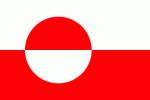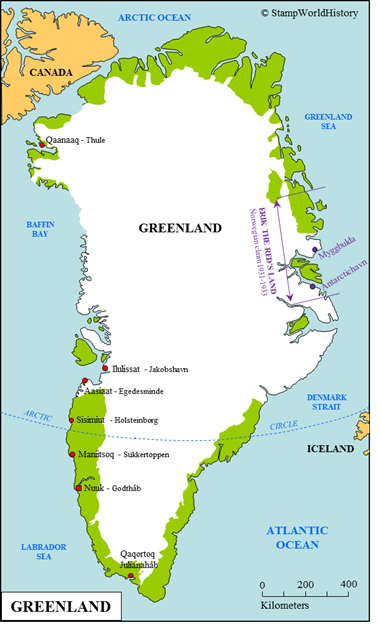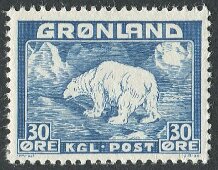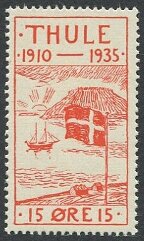
Greenland
Quick reference
General issues: Danish colony 1938-1953, Danish county 1953-1979, Self governing country within the kingdom of Denmark
Country name on general issues: Grønland, Kalaalit Nunaat
Special issues: Parcel post stamps Royal Greenland Trading Department 1905-1938, Private issues Thule 1935-1936
Currency: 1 Krone = 100 Øre
Population: 12 000 in 1905, 57 700 in 2016
Political history Greenland
Greenland is located in the northern Atlantic Ocean. Geographically, Greenland is part of North America, but politically it has been tied to Europe for over a millennium. The first Europeans to settle on Greenland were Norsemen who settled on Greenland in the 10th century. Norway established Greenland as a Norwegian possession in 1261, but the Norwegian settlements were abandoned in the 15th century.[1]It is suggested that the demise of these settlements was due to a period of lower temperatures making it more difficult to sustain the settlements. The forebears of the current indigenous people – the Inuit – settled on Greenland in the 13th century.
Although Greenland de jure remained a Norwegian possession, the kingdom of Norway had come to be ruled in personal union by the king of Denmark in 1297, and, in the 18th century, it would be the Danes who resettled Greenland. In 1776, the Kongelige Grønlandske Handel[2]Royal Greenland Trading Department was founded – a charted company that was granted the monopoly on trade with Greenland and which administered the Danish settlements. When, in 1814, the personal union between Denmark and Norway was dissolved, Denmark was de jure awarded Greenland.
The Danish government took over the administration of Greenland from the Kongelige Grønlandske Handel in 1912. In 1931, Norway claimed and settled a part of Greenland they called Erik the Red’s Land.[3]Erik the Red features in medieval myths as the founder of the first Norwegian settlement on Greenland. The Norwegians asserted that Danish rights were limited to the settled areas of Greenland. The case was presented to the Permanent International Court of Justice in the Hague which rejected Norway’s claim. Norway subsequently reneged its claim. During WWII, when Denmark was occupied by Germany, Greenland was a United States protectorate, between 1941 and 1945, to forestall possible German occupation of Greenland.
The trade monopoly of the Kongelige Grønlandske Handel ended in 1950. Greenland was elevated from a Danish colony to a Danish county[4]Counties were the administrative division of Denmark just below the national level until 2007. in 1953. In 1979, Greenland was granted self government in domestic affairs and gained the status of a constituent country of the kingdom of Denmark, which it is until today.[5]The kingdom of Denmark consists of three constituent countries: Denmark, the Faroe Islands and Greenland. Together with Denmark, Greenland joined the European Union in 1973. However, in 1985, Greenland left the European Union because of restrictions the European Union imposes on fishing, which constitutes the key economic activity in Greenland. Greenland has a high standard of living, although it is in part dependent on Danish subsidies. The population is 88% Inuit, 11% Danish and 1% of different origins. The population is concentrated on the coast as over 80% of Greenland is covered by the Greenland Ice Sheet – the only permanent ice sheet outside Antarctica. Greenlandic – Kalaallisut – is the official language since 2009, although Danish is widely spoken.
Postal history Greenland
Until 1938, regular mail in Greenland was processed free of charge by the Kongelige Grønlandske Handel. For parcels, however, a fee was charged and to cover these fees the first stamps were issued, in 1905, by the Kongelige Grønlandske Handel. The stamps read ‘Pakke-Porto’ and show the coat of arms of Greenland – the polar bear. In 1938, the Danish postal authorities took over the postal services. All mail was now charged and stamps for general use were issued from 1938. Until 1969, the country designation on the stamps was only ‘Grønland’ in Danish, but, since 1969, the stamps are also inscribed ‘Kalaalit Nunaat’ in Greenlandic. Greenland issues a moderate number of stamps with themes of national interest and themes aimed at the thematic collectors market.
Special issues appeared in 1935 for the remote settlement in Thule[6]The current Qaanaaq . Thule was an existing Inuit settlement, where the Danish explorer Knud Rasmussen established a missionary and trading post in 1910. Due to its remoteness, the settlement was, at the time, outside the range of the Danish administration of Greenland. A Thule Committee was founded to support the settlement. In 1935, with an additional value in 1936, stamps were issued by this Committee to support the settlement. The stamps commemorate the 25th anniversary of the arrival of Rasmussen in Thule. The stamps were valid for use on mail carried by the Committee’s ship from Thule to Copenhagen. If mail needed to be carried further than Copenhagen, additional franking with Danish stamps was required. The stamps were valid until 1937, when the Danish government took over the administration of Thule. Although mainly sold to collectors, the stamps have served a genuine postal use.[7]The Thule issues are listed in the Michel and Yvert & Tellier catalogs and also in the Facit specialized catalog for the countries of Scandinavia.
Album pages
← Previous page: FinlandNext page: Iceland →





